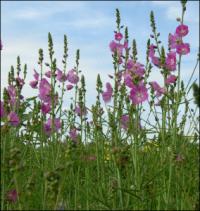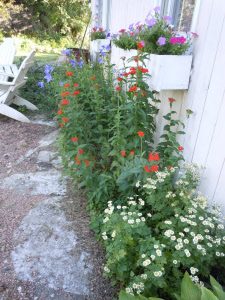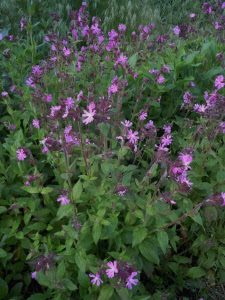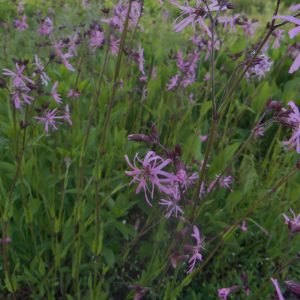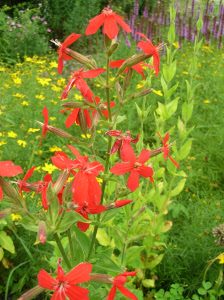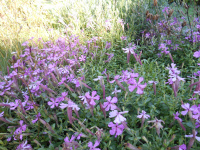Perennials & Biennials
Showing 417–424 of 485 results
-
Sesleria autumnalis Autumn Moor Grass Z 5-9
Fresh-green spring narrow blades of grass in summer add airy purplish flower spikes with silver-white stamens on this low mounding, arching grass. Blades have a striking yellow-green color that sometimes develops a soothing golden autumn tint. Spike-like silvery flowers rise above the leaves and mature into soft tan seed heads by autumn.
Fresh-green spring narrow blades of grass in summer add airy purplish flower spikes with silver-white stamens on this low mounding, arching grass. Blades have a striking yellow-green color that sometimes develops a soothing golden autumn tint. Spike-like silvery flowers rise above the leaves and mature into soft tan seed heads by autumn.
Size: 16-18” x 12-18”
Care: sun to part shade in moist well-drained to well-drained soil, drought tolerant
Native: SE Europe east to Caucusus
Wildlife Value: walnut, salt and deer tolerant
Awards: Royal Horticultural Society Award of Garden Merit. Gardens Illustrated “100 Must-Have Garden Plants,” 2013.Collected in Slovenian mountains near Idria, c. 1760 by and 1st described in Flora Carniolica by Giovanni Antonio Scopoli (1723-1788) physician, naturalist and author. Sesleria is named to honor Leonardo Selser, 18th century Italian botanist and physician, contemporary and likely friend of Scopoli
-
Sidalcea malvaeflora Checker bloom Z 5-9
Bright pink mallow type blooms looking like a miniature hollyhock.
Bright pink mallow type blooms looking like miniature hollyhock.
Size: 2-3' x 10"
Care: sun to part shade in well-drained soil
Native: western No. America
Wildlife Value: Attracts large white skipper butterflies.Sidalcea is the conjunction of sida and alcea. Collected by Mexican botanist José Moziño around 1790 while on the Expedición Real de Botánica, probably in today’s Southern California.
-
Silene chalcedonica syn. Lychnis chalcedonica Maltese cross, Jerusalem cross Z 4-8
Early and midsummer, blood-colored heads made of clusters of flowers each with petals like spokes of a wheel with edges curved down. Blooms in summer.
Early and midsummer, blood-colored heads made of clusters of flowers each with petals like spokes of a wheel with edges curved down. Blooms in summer.
Size: 3-4' x 12"
Care: Sun to part shade, moderately fertile, well-drained soil. Will repeat bloom if deadheaded.
Native: Western Russia
Awards: England’s Royal Horticultural Society Award of Merit.Lychnis named by Theophrastus in the 3rd century B.C. for “lamp” (lychnos) due to using the leaves of Lychnis coronaria for lamp wicks, but some say due to the flame-colored flowers. Chalcedonica refers to Chalcedon, a district near Constantinople. Louis IX reputedly transported this plant from Jerusalem to France on his return from the Crusades. By 1597 it was “very common everywhere” in England. In 1912 Liberty Hyde Bailey called this “one of the best of old-fashioned flowers.” Grown by both Washington and Jefferson.
-
Silene coronaria syn. Lychnis coronaria Rose campion Z 4-8
Bright crimson/magenta 5-round-petaled flowers contrast felted silvery-white foliage in early to midsummer. Be sure to let it drop its seeds for more plants next year or the year after.
Bright crimson/magenta 5-round-petaled flowers contrast felted silvery-white foliage in early to midsummer. Be sure to let it drop its seeds for more plants next year or the year after.
Size: 24" x 18"
Care: Full sun in moist well-drained to well-drained soil
Native: Southeastern Europe
Awards: England's Royal Horticultural Society Award of Merit.Lychnis named by Theophrastus in the 3rd century B.C. for “lamp” believed to be because the downy leaves were used to make lamp wicks, but some say due to the flame-colored flowers. Mythology reports that the Rose campion sprang from the bath of Aphrodite. Rose campion has been in European garden cultivation since the 1300’s. Parkinson in 1629 wrote of the Rose campion: “The single red Rose campion hath divers thick, hoary or woolly long greene leaves, abiding greene all the winter, and in the end of the spring or beginning of summer, shooteth forth two or three hard round woolly stalkes, with some joints thereon, and as every joint two such like hoary greene leaves as those below, but smaller, diversly branched at the toppe, having one flower upon each severall long stalke … of a perfect red crimson colour …” Paradisi in Sole Paradisus Terrestris. Both George Washington and Thomas Jefferson grew this plant. (Jefferson in 1807.)
-
Silene dioica Red Campion Z 5-8
Dark pink-purple flowers from late spring to mid-summer
Dark pink-purple flowers from late spring to mid-summer
Size: 32” x 18”
Care: full sun to part shade in moist well-drained soil
Native: Europe
Wildlife Value: a favorite of BumblebeesIn Greek mythology Silene was a companion of Bacchus who was covered with foam. Dioicus means that male and female plants are separate. Described by 1750’s. Grown in American gardens since 1800’s
-
Silene flos-cuculi syn. Lychnis flos-cuculi Ragged robin Z 4-9
May-June, cotton-candy pink star shaped of thin petals as if a bursting star.
May-June, cotton-candy pink star shaped of thin petals as if a bursting star.
Can not ship to: Connecticut and Maryland.
Size: 30” x 32”
Care: Sun to part shade, moist well-drained soil
Native: Europe, Caucasus, Russia
Wildlife Value: Butterfly plant, attracts Small Pearl Bordered Frilillary and Common BlueFlos is Latin for “flower.” According to Parkinson (1629) Ragged robin was used to cure wounds as early as Roman times. Grown by Washington at Mount Vernon. In 1851 Breck called the Ragged robin “an old inhabitant of the flower garden.”
-
Silene regia Royal catchfly Z 5-8
True crimson stars, brighter than a stop light, in July – September, from the prairies.
OUT OF STOCK
True crimson stars, brighter than a stop light, in July – September, from the prairies.
Size: 2-3’ x 1-2’
Care: sun to part shade in moist well-drained soil
Native: from Ohio to Alabama W. to Nebraska, WI native
Wildlife Value: hummingbird favorite.In Greek mythology Silene was a companion of Bacchus who was covered with foam. French plant hunter Andre Michaux may have been the 1st to collect this c. 1800. Grown from seed collected by English planthunter Thomas Nuttall (1786-1859) near St. Louis on the Mississippi River c. 1812.
-
Silene schafta Schaft’s catchfly, Moss Z 5-7
One of the spectacular late season blooms –clusters of five-petaled, jagged-edge, bright magenta flowers on short mounds, September to October. Perfect for front of borders or rock gardens.
OUT OF STOCK
One of the spectacular late season blooms –clusters of five-petaled, jagged-edge, bright magenta flowers on short mounds, September to October. Perfect for front of borders or rock gardens.
Size: 6” x Slowly spreading
Care: full sun in well-drained to moist well-drained soil
Native: Russia
Awards: England’s Royal Horticultural Society Award of MeritIntroduced from its native Russia in 1844. First described by and probably collected by Johann Gmelin (1709-1755) German naturalist who spent years hunting plants in Russia and authored four-volume Flora Sibirica. In Greek mythology Silene was a companion of Bacchus who was covered with foam. William Robinson, father of the mixed perennial border, described the flowers of this species as being “very neat tufts.”


